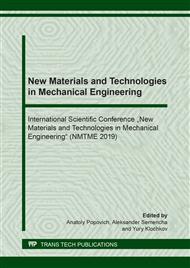[1]
L.A. Magerramova, G.A. Turichin, Y.A. Nozhnitsky, O.G. Klimova-Korsmik, B.E. Vasiliev, M.E. Volkov, A.V. Salnikov, Peculiarities of additive technologies application in the production of gas turbine engine parts, Journal of Physics: Conference Series, 1109 (1) (2018) 012051.
DOI: 10.1088/1742-6596/1109/1/012051
Google Scholar
[2]
R.V. Mendagaliyev, O.G. Klimova-Korsmik, K.M. Medvedeva, A.A. Voropayev, A.D. Eremeev, I.A. Tsibulsky, E.A. Norman, Features of structure formation and properties at laser and arc surfacing from steel wire, Journal of Physics: Conference Series (2018), 1109 (1), 012040.
DOI: 10.1088/1742-6596/1109/1/012040
Google Scholar
[3]
S.A. Shalnova, O.G. Klimova-Korsmik, M.O. Sklyar, Influence of the roughness on the mechanical properties of ti-6al-4v products prepared by direct laser deposition technology, Solid State Phenomena 284 (2018), 312-318.
DOI: 10.4028/www.scientific.net/ssp.284.312
Google Scholar
[4]
V. Glukhov, G. Turichin, O. Klimova-Korsmik, Quality management of metal products prepared by high-speed direct laser deposition technology, Key Engineering Materials 684 (2016) 461-467.
DOI: 10.4028/www.scientific.net/kem.684.461
Google Scholar
[5]
M.O. Sklyar, O.G. Klimova-Korsmik, V.V. Cheverikin, Formation structure and properties of parts from titanium alloys produced by direct laser deposition, Solid State Phenomena 265 (2017), 535-541.
DOI: 10.4028/www.scientific.net/ssp.265.535
Google Scholar
[6]
I.A. Tsibulskiy, V.V. Somonov, R.S. Korsmik, M.O. Gushchina, A.D. Eremeev, The influence of technological parameters on the structure formation of aluminum alloys during direct deposition of wire, Journal of Physics: Conference Series (2018), 1109 (1), 012032.
DOI: 10.1088/1742-6596/1109/1/012032
Google Scholar
[7]
M. Biegler, A. Marko, B. Graf, M. Rethmeier, Finite element analysis of in-situ distortion and bulging for an arbitrarily curved additive manufacturing directed energy deposition geometry, Additive Manufacturing, 24 (2018) 264-272.
DOI: 10.1016/j.addma.2018.10.006
Google Scholar
[8]
M. Gouge, P. Michaleris, Thermo-Mechanical Modeling of Additive Manufacturing, first ed., Butterworth-Heinemann, (2017).
Google Scholar
[9]
G. Turichin, E. Zemlyakov, K. Babkin, S. Ivanov, A. Vildanov, Analysis of distortion during laser metal deposition of large parts, Procedia CIRP, 74 (2018) 154-157.
DOI: 10.1016/j.procir.2018.08.068
Google Scholar
[10]
P.A. Golovin, A.M. Vildanov, K.D. Babkin, S.Y. Ivanov, I.K. Topalov, Distortion prevention of axisymmetric parts during laser metal deposition Journal of Physics: Conference Series, 1109 (1) (2018) 012065.
DOI: 10.1088/1742-6596/1109/1/012065
Google Scholar
[11]
T. Mukherjee, W. Zhang, T. DebRoy, An improved prediction of residual stresses and distortion in additive manufacturing, Computational Materials Science, 126 (2017) 360-372.
DOI: 10.1016/j.commatsci.2016.10.003
Google Scholar
[12]
V.T. Em, S.Y. Ivanov, I.D. Karpov, S.A. Rylov, E.V. Zemlyakov, K.D. Babkin, Residual stress measurements of laser metal deposited Ti-6Al-4V parts using neutron diffraction, Journal of Physics: Conference Series, 1109 (1) (2018) 012049.
DOI: 10.1088/1742-6596/1109/1/012049
Google Scholar
[13]
Z. Wang, E. Denlinger, P. Michaleris, A.D. Stoica, D. Ma, M. Beese, Residual stress mapping in Inconel 625 fabricated through additive manufacturing: Method for neutron diffraction measurements to validate thermomechanical model predictions, Materials & Design, 113 (2017) 169-177.
DOI: 10.1016/j.matdes.2016.10.003
Google Scholar
[14]
F. Bayerlein, F. Bodensteiner, C. Zeller, M. Hofmann, M.F. Zaeh, Transient development of residual stresses in laser beam melting – A neutron diffraction study, Additive Manufacturing, 24 (2018) 587-594.
DOI: 10.1016/j.addma.2018.10.024
Google Scholar
[15]
T. Debroy, H. L. Wei, J. S. Zuback, T. Mukherjee, J. W. Elmer, J. O. Milewski, Allison Michelle Beese, A. Wilson-Heid, A. De, W. Zhang, Additive manufacturing of metallic components – process, structure and properties, Progress in Materials Science, 92 (2018) 112-224.
DOI: 10.1016/j.pmatsci.2017.10.001
Google Scholar
[16]
D.D. Gu, W. Meiners, K. Wissenbach, R. Poprawe, Laser additive manufacturing of metallic components: materials, processes and mechanisms, International materials reviews 57, 3 (2012) 133-164.
DOI: 10.1179/1743280411y.0000000014
Google Scholar
[17]
Y. Ueda, Welding Deformation and Residual Stress Prevention, first ed., Butterworth-Heinemann, (2012).
Google Scholar
[18]
L.E. Lindgren, Computational Welding Mechanics, first ed., Woodhead Publishing, (2007).
Google Scholar
[19]
K.C. Mills, Recommended Values of Thermophysical Properties for Selected Commercial Alloys, Woodhead Publishing, Cambridge, (2002).
Google Scholar
[20]
Nickel Development Institute, High-temperature high strength nickel base alloys, Nickel Development Institute, 393 (1995).
Google Scholar


